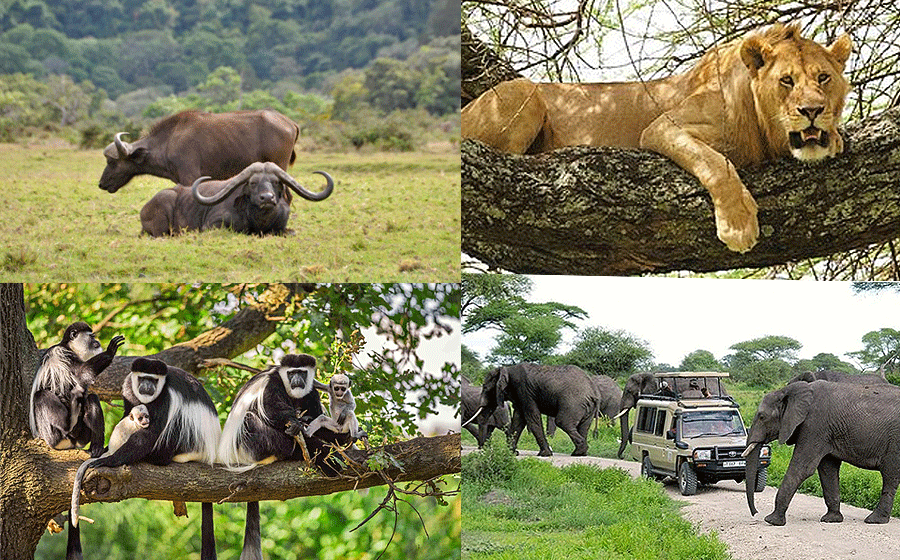Arusha National Park
Arusha National Park is a serene expanse nestled in the northern circuit of Tanzania, a stone’s throw away from the bustling city of Arusha. Spanning 552 square kilometers, this park is a treasure trove of natural wonders, bordered by the majestic Mount Meru, Africa’s fifth-highest peak, which rises to an impressive 4,566 meters. Its strategic location places it 25 kilometers east of Arusha, 58 kilometers from Moshi, and a mere 35 kilometers from Kilimanjaro International Airport (KIA), making it an accessible haven for nature lovers and adventure seekers alike. The park’s wildlife is a tapestry of Africa’s finest, with the world’s largest population of giraffes gracefully roaming the savannah.
The diverse fauna also includes Cape buffaloes, zebras, warthogs, and bushbucks, while the forests shelter primates like the black-and-white colobus monkeys and blue monkeys. The elusive leopard may also make a rare appearance, adding a dash of excitement to the game-viewing experience. The birdlife is equally captivating, with over 400 species recorded. The Momella Lakes are a particular highlight, where flocks of flamingos congregate, creating a mesmerizing spectacle of pink against the backdrop of verdant hills. Beyond the allure of wildlife, Arusha National Park offers a range of activities to immerse oneself in the raw beauty of the landscape.
The ascent of Mount Meru is a challenging trek that rewards climbers with breathtaking vistas, while guided walking safaris provide an intimate encounter with the park’s inhabitants. For a tranquil experience, canoeing on the Momella Lakes offers a unique perspective of the park’s avian life and the animals that frequent its shores.

Arusha National Park, a sanctuary nestled on the foothills of Mount Meru, beckons travelers to explore its diverse offerings. This park, situated a mere 45 minutes drive from Arusha City center, is a testament to nature’s splendor, boasting the title of Africa’s most beautiful volcano and fifth highest peak. The park serves as an ideal high-altitude acclimatization ground for those preparing to ascend Kilimanjaro, offering a wealth of attractions disproportionate to its size.
The park’s landscapes are a study in contrasts, featuring the rugged terrains of Mount Meru and the Ash Cone, the serene Momella Lakes, and the lush tropical forest glades of the Ngurdoto Crater. Visitors are treated to a variety of experiences, from game viewing and horse riding to climbing Mount Meru and embarking on ranger-led walks. These activities allow for an intimate appreciation of the park’s natural beauty.
Despite its modest size, Arusha National Park offers a rich tapestry of wildlife, including giraffes, Cape buffaloes, zebras, warthogs, and many other African animals. The park’s varied landscapes, including the Meru Crater, Ngurdoto Crater, and Momella Lakes, contribute to its allure, making it a must-visit destination for those seeking a serene yet adventurous retreat.
Arusha National Park is also a premier birding destination, home to over 400 bird species. The park’s avifauna includes forest species, raptors, water birds, and migratory birds, with notable inhabitants like the pink-hued flamingoes, African fish eagle, and the majestic Verreaux’s eagle. The Momella Lakes serve as a canvas for the flamingoes, creating a vibrant spectacle that is a highlight for bird enthusiasts.
Arusha National Park is not just a wildlife haven but also an adventurer’s playground. The park offers a variety of activities that allow visitors to immerse themselves in its natural splendor. One of the most exhilarating challenges is climbing Mount Meru, a trek that is as rewarding as it is demanding. Often undertaken as a warm-up for Kilimanjaro, the hike up Mount Meru can be completed in three to four days and offers climbers stunning panoramic views from the ash cone and crater rim. On clear days, the sight extends to the distant Kilimanjaro, enhancing the sense of achievement upon reaching the summit.
For those seeking a more serene yet equally engaging experience, Arusha National Park provides guided walking safaris and ranger-led activities. These walks are a chance to get up close with the park’s diverse flora and fauna, meandering through tropical forests and exploring the crater floor. Additionally, the park offers canoeing on the Momella Lakes, a peaceful activity that allows for quiet observation of water birds and thirsty animals along the shores. These activities are designed to offer a more intimate and personal connection with the park’s environment, perfect for nature enthusiasts eager to delve deeper into the wonders of Arusha National Park.
Arusha National Park Facts
Arusha National Park Vegetation | Ecosystem
Arusha National Park’s ecosystem is a vibrant tapestry of natural habitats, each supporting a diverse array of flora and fauna. The park encompasses the lush montane forests on the slopes of Mount Meru, the second-highest mountain in Tanzania, which provides a home to colobus monkeys, leopards, and a variety of bird species. The open savannah and acacia woodlands offer a habitat for giraffes, zebras, and warthogs, while the Ngurdoto Crater and Momella Lakes add to the park’s ecological diversity. The lakes, known for their wading birds, vary in algal colors, creating a unique and picturesque landscape. This rich mosaic of environments within Arusha National Park makes it a unique and important conservation area.
Climate: Dry & Wet Season | Best Time to Visit
The climate in Arusha National Park is temperate and varies with the altitude, offering visitors a comfortable environment for exploration. Wildlife viewing is consistently good year-round, but it reaches its peak during the Dry season, from June to October, when animals congregate around water sources and the vegetation is less dense, making them easier to spot. The scenery is most lush and impressive during the Wet season, from November to May, although March and April can be particularly wet1. Clear skies from December to February provide the best views of Mount Meru and Kilimanjaro, adding to the park’s allure. Despite the possibility of rain, the park’s diverse habitats and wildlife can be enjoyed at any time of the year.
Location | How to get to Arusha National Park
Arusha National Park is located in northern Tanzania, approximately 25 kilometers east of the town of Arusha. The park is easily accessible by road, with the journey taking about 45 minutes from Arusha. Many visitors opt to hire a private driver or join a guided tour to reach the park. For those coming from afar, the closest major airport is Kilimanjaro International Airport (JRO), which is about 50 kilometers away, with the drive from the airport to Arusha taking around 1.5 hours. The park’s location and accessibility make it a convenient destination for both day trips and longer safari itineraries, allowing visitors to immerse themselves in nature without venturing far from urban comforts.
Mammals | Wildlife & Animals
Arusha National Park is a haven for a variety of mammals and other wildlife, offering visitors a chance to see some of Tanzania’s most iconic species. The park is known for its large groups of giraffes, which are commonly seen against the backdrop of Mount Meru. Other frequently spotted animals include Cape buffaloes, zebras, warthogs, and bushbucks. The park’s forests are home to primates like the blue monkey and the Kilimanjaro colobus, which are not often encountered in northern Tanzania. While the park has predators like leopards and spotted hyenas, they are rarely seen. The park also provides a sanctuary for less common species such as Harvey’s red duiker and suni, making it a special destination for wildlife enthusiasts.
Bird Checklist | Birdlife
Arusha National Park is a birdwatcher’s paradise, with a bird checklist that includes over 619 species. The park’s varied habitats, from the montane forests to the savannah and the alkaline Momella Lakes, support an impressive diversity of birdlife. Among the many species, visitors can spot the Greater and Lesser flamingos at the lakes, while the forested areas are home to the Silvery-cheeked hornbill and Hartlaub’s turaco. Raptors such as the Augur buzzard and Verreaux’s eagle are also commonly seen soaring above the park’s landscapes. The presence of both resident and migratory birds throughout the year ensures that any visit to Arusha National Park will be a rewarding experience for bird enthusiasts.
Arusha National Park Entrance Fees
|
Dates From |
Dates To | East Africa Citizen | Expatriates |
Non-Residents |
|
1st Jan 2024 |
14th Mar 2024 | 10,000 Tanzania Shillings |
30 US Dollars | 59 US Dollars |
| 15th Mar 2024 | 15th May 2024 | 10,000 Tanzania Shillings |
26.5 US Dollars |
48 US Dollars |
|
16th May 2024 |
31st Dec 2024 | 10,000 Tanzania Shillings |
30 US Dollars |
59 US Dollars |
|
Child Rate – Aged Between 5-15 Years |
||||
| Dates From | Dates To | East Africa Citizen | Expatriates |
Non-Residents |
|
1st Jan 2024 |
31st Dec 2024 | 2,000 Tanzania Shillings |
9 US Dollars |
18 US Dollars |
Notes
* Children below the age of 5 years – free
Arusha National Park Rates Exclude:
* Fines
* Vehicle fees
* Landing fees
* Filming fees
* Concession fees
* Extra activities fees
Arusha National Park Opening Time
Arusha National Park operates between the hours of 06:00 to 18:00. This schedule allows visitors to make the most of the daylight for various activities such as game drives, walking safaris, and bird watching. It’s always a good idea to arrive early to maximize your time in the park and to experience the wildlife during the cooler parts of the day when animals are more active.
Arusha National Park Activities
Mount Meru: Dominating the park’s landscape is Mount Meru, an active stratovolcano that is the second-highest peak in Tanzania. It offers challenging treks to its summit, providing climbers with spectacular views of the crater and the savannah. The climb typically takes three to four days and is a popular acclimatization hike for those planning to ascend Mount Kilimanjaro.
Ngurdoto Crater: Often referred to as the ‘Little Ngorongoro’, the Ngurdoto Crater is a volcanic crater with steep sides and a lush, swamp-filled floor. It’s a haven for wildlife, including buffalo and warthogs, and offers excellent opportunities for game viewing from the crater rim.
Momella Lakes: The Momella Lakes are a series of seven alkaline lakes, each with a different hue due to the varying algae and mineral content. These lakes attract a wide variety of water birds, especially flamingos, and are a perfect spot for bird-watching and canoeing.
Tululusia Hill: For those who enjoy a good hike, Tululusia Hill provides a scenic trail through lush forest leading to a waterfall and an ancient fig tree. It’s also a great spot for birdwatching and enjoying panoramic views of the park.
Colobus Trail: The Colobus Trail is a walking path that allows visitors to explore the montane forest where the black-and-white colobus monkeys reside. This trail is an excellent way to see these beautiful primates up close in their natural habitat.
Booking & Reservations, Arusha National Park, Contact
Mobile: +254-721-242-711
WhatsApp: +254-721-242-711
Reservations: +254 718-179-967
Email: info@africanspicesafaris.com
Website: https://africanspicesafaris.com
